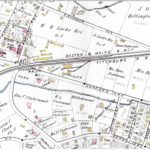
By Vincent Stanton, Jr.
It has taken over two decades of stop-and-start development to bring the Belmont Community Path to its current state of planning and formal design, but a timeline for construction of the path is finally in sight. The design and engineering of Phase I of the Belmont Community Path, from Brighton Street to the Clark Street Bridge, started last fall and should take about two years to complete.
In the next two years, path plans will progress through three major milestones: 25, 75, and 100 percent design, as part of a Massachusetts Department of Transportation (MassDOT) guided process. At each state of completion plans will be reviewed by MassDOT, the MBTA and the Town of Belmont. Following the 100% design review, final plans, specifications, and estimates (PS&E) will be completed in the spring of 2022.
Once the PS&E documents are complete the project can go out to bid. While the design proceeds, Belmont will also be pursuing construction funding through the federally funded Transportation Improvement Program (TIP), administered by the Boston Metropolitan Planning Organization.
Construction will only start once TIP funding is in place, and will take at least another year. At some point, probably well before Phase 1 construction begins, planning will start for Phase 2, which runs from the Clark Street Bridge to the Belmont/Waltham line, and the entire cycle will repeat.
That may seem like a very long wait, but viewed in historical context we are much closer to the end than the beginning. Here is a chronology of the events that shaped current plans for the Belmont Community Path.
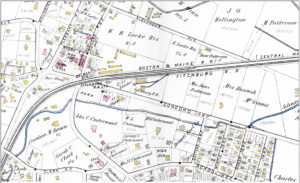
Map of the Fitchburg and Massachusetts Central Railroad lines crossing Belmont from the 1900 Atlas of Middlesex County. The Belmont Center Railroad bridge on Leonard Street was built in 1907. Graphic courtesy of Vincent Stanton, Jr.
1843: Railroads Come to Belmont
The Fitchburg Railroad opens with service from North Station, Boston, to Waltham via Belmont on the flattest available route, north of Cushing Corner, south of Belmont Hill. The railroad is extended from Belmont to Fitchburg the next year.
1881: Trains Run on Future Community Path Route
The Massachusetts Central Railroad (MCRR) opens with service from Cambridge to Hudson via Belmont. In Belmont, the MCRR tracks run parallel to the Fitchburg Railroad tracks, on the north side.
Over the next six years, the MCRR extends its tracks all the way to Northampton, MA, 104 miles from Boston. In 1887 the Boston and Maine Railroad acquires the MCRR.
A significant part of the former MCRR right of way will be used for Belmont’s community path. West of Beaver Street in Waltham, the MCRR splits from the Fitchburg Line, and from that point west it is an abandoned right of way owned by the MBTA. In 2010 the MBTA leases the former MCRR right of way (from Waltham to Berlin, MA) to the Division of Conservation and Recreation (DCR) for recreational use for a term of 99 years.
1970: MBTA Buys Bankrupt Railroads
The Boston and Maine Railroad files for bankruptcy. In 1976, the Massachusetts Department of Public Works acquires the Boston and Maine Railroad property (trackage and equipment) for the present commuter rail system, including the abandoned MCRR and Fitchburg Lines. The commer rail system later becomes part of the MBTA.
1982: A Tragic Death on the Tracks
On December 6, a Belmont High School student dies in a train collision on the tracks near the high school.
1983: Town Pledges to Make Path Safer
Following the student death, “concern was expressed for the safety of the many High School students who cross the railroad embankment daily on their way to and from school,” according to a report by the Underpass Study Committee. On April 25, Belmont Town Meeting adopts Article 49, which calls for “. . . the question of providing a pedestrian link between Alexander Avenue Extension and the high school playing field be referred to a committee to be appointed by the Board of Selectmen to study and report to the next Annual Town Meeting.”
The committee determines that an underpass is too expensive (estimated cost: up to $500,000). Instead, they recommend a surface pedestrian and bicycle crossing with gates with an estimated cost of less than $30,000. The committee speculates that the state might pay for 75% of a combined pedestrian/bicycle path.
1994: River Path Piques Public Interest
The Board of Selectmen forms the Bikeway Planning Committee in response to interest in a new path linking the Paul Dudley White Bike Path, which runs along the Charles River, to Alewife Station and Belmont Center. The possibility that the new path could get federal funding is raised. A similar path from Alewife to Belmont Center was first discussed in the late 1980s, when the Minuteman Bike path was being planned.
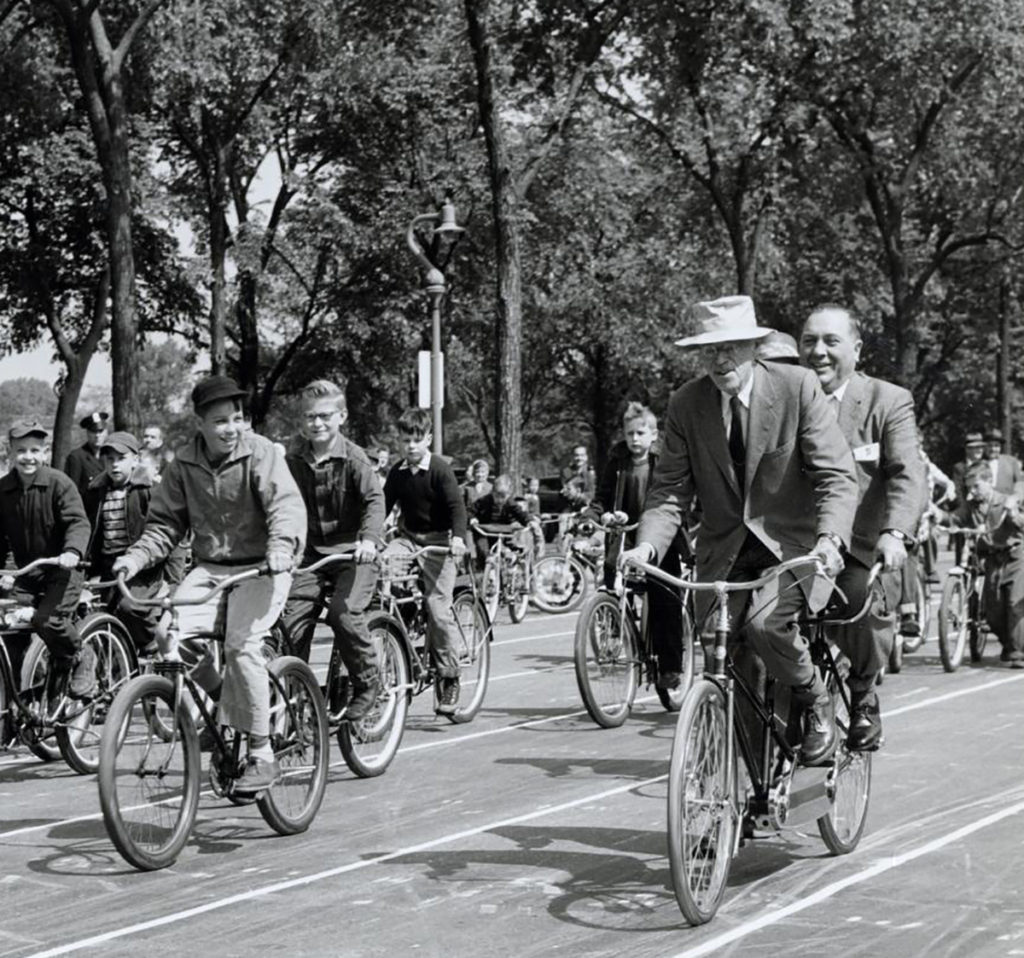
Dr. Paul Dudley White (front) pedals with Chicago’s Mayor Richard Daley at the 1956 opening of the Ogden Avenue bicycle path. Photo: UIC
Paul Dudley White: “Walk more, eat less, sleep more.”
Boston’s famous bike path along the Charles River is named for a Belmont resident. In the 1950s, Belmont’s Paul Dudley White becomes the most prominent national advocate for dedicated bicycle paths as part of his larger campaign to encourage Americans to exercise more.
Dr. White, who rose to public fame late in his career as President Dwight Eisenhower’s cardiologist, was an advocate of exercise—walking and bicycling specifically—from the 1920s to his death in 1973. He successfully lobbied Mayor Richard Daley of Chicago to create a bicycle path; White and Daley are pedaling a two seater at the opening above.
White also cofounded and led the Committee for Safe Bicycling, which successfully advocated for the first state-sponsored bike path in Massachusetts, on Nantucket, built in 1958, and for the path around the Charles River Basin that was named for him in 1975.
1995: Belmont Joins Rail Trail Study
The Belmont selectmen approve Belmont’s participation in the Central Massachusetts Rail Trail Feasibility Study. The study is conducted by the Central Transportation Planning Staff (CTPS) of the Boston Metropolitan Planning Organization, a regional planning organization serving 97 communities in eastern Massachusetts. Belmont is a critical link in the Massachusetts Central Rail Trail (MCRT) to be built along a part of the 104-mile Massachusetts Central Railroad right of way, between Alewife Station and Berlin, MA.
1997: Report Details Belmont’s Rail Trail Challenges
CTPS releases the Central Massachusetts Rail Trail Feasibility Study. Three aspects of the study inform Belmont’s subsequent work to develop a community path.
1. A path through Belmont was deemed feasible. The routes considered in later studies were all described first in this study.
2. Belmont has two challenges that the other five communities did not share: the path would run next to a live train line, as far as Beaver Street in Waltham; and large segments of the former Mass Central Railroad right of way in Belmont had been sold to private parties.
3. Many Channing Road residents expressed opposition to a path along the north side of the Fitchburg line on the former Mass Central Railroad right of way.
1997: Belmont Looks at Path Routes
The town commissions a more detailed study of possible routes: the Belmont Bikeway Preliminary Feasibility Analysis. The study introduces the idea of the bikeway as a community path connecting neighborhoods to public amenities such as the high school playing fields, the Underwood Pool, and the library. Possible routes on both the north and the south side of the Fitchburg Line were delineated.
1998: Recession Pauses Path Progress
The selectmen vote to participate in the design process for the MCRT with the caveat that the town will back out if it is not satisfied with trail design in Belmont. Soon afterwards, the MCRT design process stalls when Weston reverses a 1997 vote of support and withdraws from the project. Progress is also impeded by reduced federal and state funding during the 2001 recession. Other communities continued to move forward on their own, and the DCR continued to advance permitting of the MCRT west of Belmont, albeit slowly.
2008: BCF Buys Path Land
The Belmont Citizens Forum (BCF) purchases a long, thin strip of land parallel to and north of the Fitchburg Line along Channing Road. The parcel was part of the Massachusetts Central Railroad right of way, sold to a private citizen by the Boston and Maine Railroad as it was sliding into bankruptcy in 1971. The BCF publicly states its intent to donate the property to the town for use in a future community path.
2010: Brighton Path Building Begins
Construction begins on Belmont’s first community path, the Fitchburg Cutoff Path from Brighton Street to Alewife Station, with Belmont’s portion of the path amounting to 683 feet. Belmont state Representative Anne Paulson was instrumental in moving this project forward. MassDOT supervises the path’s design and construction, which was funded with federal transportation dollars via the regionally administered Transportation Improvement Program (TIP).
2010: DCR Leases Path Land From MBTA
The Massachusetts Department of Conservation and Recreation (DCR) signs a 99-year lease with the MBTA allowing development of a trail along the Mass Central Railroad corridor between Beaver Street in Waltham and Berlin, just west of route 495.
DCR leads environmental and historical permitting for the MCRT along the leased corridor and provides a generic design for a 19-foot-wide corridor. Each town is responsible for conducting additional reviews and for detailed path design.
2011: MAPC Releases Belmont Study
The Metropolitan Area Planning Council(MAPC) releases a draft Belmont/Waltham Community Trail Alignment Study (the final version is issued in 2012) and presents its findings to the Belmont selectmen and the public. The study divides Belmont into five segments from the Waltham border to the Cambridge border. It also identifies at least two possible trail alignments in each segment and a preferred route for four segments. An Alexander Avenue underpass is strongly recommended, regardless of whether the path is located on the north or south side of the Fitchburg Line. The study also notes that some Channing Road residents continue to oppose the path.
2011-2012: DCR Gets Path Easement
Michael Mahoney, as a condition of obtaining a building permit for the French and Mahoney complex at 40-42 Brighton Street, grants DCR an easement across his property for a possible future community path.
2012-2014: Belmont Path Committee Appointed
The Belmont Board of Selectmen form the Community Path Advisory Committee (CPAC) to solicit community input about path features, to identify, study and rank potential routes, and to make recommendations about next steps. CPAC delivered its final report and recommendations to the selectmen in June 2014.
The top-ranked route runs along the north side of the tracks from the Waltham border to Waverley Station, shifting to the south side of the tracks from Waverley to Belmont Center Station, then back to the north side of the tracks to the Fitchburg Cutoff Path at Brighton Street. CPAC recommends a feasibility study to evaluate at least two route segments throughout Belmont, one north and one south of the Fitchburg Line.
2013: Belmont Path Gap Rated Region’s #2 Priority
CTPS releases the Bicycle Network Evaluation study which ranks 232 gaps in the community path network inside Route 495. The gap between Waltham and Waverley Square, Belmont, is ranked the second-highest priority in the region, exceeded only by a segment of the Somerville Community Path which was subsequently built.
2014-2017: New Bike Path Committee, Feasibilty Study
The Board of Selectmen forms the Community Path Implementation Advisory Committee (CPIAC) to oversee a feasibility study of path routes identified by CPAC and earlier studies.
In June 2015, Belmont Town Meeting votes to appropriate $100,000 for a community path feasibility study. State Representative David Rogers and state Senator William Brownsberger secure another $100,000 from the state transportation budget for the study.
CPIAC selects the Pare Corporation and K3 Landscape Architecture team to perform the study. The Pare/ K3 Landscape Architecture team holds 10 public meetings in 2016 and 2017, submitting their Feasibility Study for the Belmont Path to CPIAC and the Board of Selectmen in November 2017. The feasibility study makes several innovative recommendations including:
A route along the north side of the Fitchburg Line from the Waltham border to Waverley Station, where a new “box-over” design would cover the tracks. The small existing park at the station could be expanded over the entire train platform, with the community path traversing the park between Lexington Street and Trapelo Road.
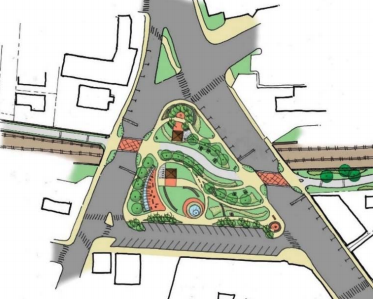
Illustration of the proposed “box-over” park for Waverley Square featuring a central lane for the bike path. This design was featured in the 2017 Feasibility Study for the Belmont Community Path. Illustration by Pare Corporation / K3 Landscape Architecture
A route along the south side of the Fitchburg Line from Waverley to the Belmont Housing Authority (BHA) parking lot, leading to a new pedestrian/bicycle bridge crossing from behind the BHA building at 59 Pearson Road to the north side of the Fitchburg Line just west of the Clark Street Bridge
A route along the north side of the Fitchburg Line through Belmont Center and along the tracks behind Channing Road until Alexander Avenue, then crossing under the tracks to the south side, and crossing back to the north at Brighton Street
2015-2017: Track Work Limits Belmont Path Options
The Fitchburg Line Improvement Project, a five-year, $306-million-dollar, federally funded project to improve service along the entire 53 mile line, involved extensive construction in Belmont. New track was laid from Belmont Center to Brighton Street, along with two new north-south track cross-overs, a new signaling system, three new signal houses on the south side of the tracks (abutting the high school property) and four new signal towers. The MBTA altered the location of one signal house to accomodate a possible future underpass at Alexander Avenue Extension based on input from the Belmont selectmen. The new signal houses limit the space for a path along the south side of the tracks.
2018-2019: Belmont Pursues Path Funding
In March 2018, Senator Brownsberger, working with the Board of Selectmen, the town administrator, and the CPIAC chair, determines that MassDOT is willing to accept the Belmont path as a TIP-funding eligible project in two intersecting parts:
A north-south path from Channing Road to Concord Avenue via an underpass at Alexander Avenue (Phase 1A).
An east-west path along the Fitchburg Line from Brighton Street to the Clark Street Bridge. The town can specify the final route for this segment later (north vs. south of the tracks) (Phase 1B)
This approach allows the town to move ahead with the Belmont Community Path while postponing a final decision on the route east of Alexander Avenue. Phase 2 of the community path, from the Clark Street Bridge to the Waltham border, will follow. In June, the town applies for TIP funding eligibility, and in July MassDOT accepts Belmont’s application.
The Board of Selectmen, recognizing that the Pare study’s top route recommendation involves traversing land owned by Purecoat North, asks if the property owner will grant an easement to Belmont and allow demolition of the north wall of the Crate Escape building to create space for the path. The answer is no, and in 2019 the selectmen vote to route the path along the north side of the Fitchburg Line from Alexander Avenue to Brighton Street. (The MBTA also expressed “dire concerns” about a path crossing the Fitchburg Line at Brighton Street in a November 2018 letter to the selectmen.)
In November 2018, Town Meeting appropriates $400,000 of Community Preservation Act funds for design of the Phase 1A of the Belmont path in order to synchronize path design with the design of the new middle-high school. The selectmen appoint the Community Path Project Committee (CPPC) to hire a design and engineering team for the path and to help the town secure state and federal funding for construction.
2019: Design Work Begins
In April 2019, CPPC issues a request for proposals for phases 1A and 1B of path design.They select the Nitsch Engineering team. Nitsch had designed the Fitchburg Cutoff Path and several other segments of the MCRT.
In May 2019, Town Meeting appropriates $1,000,000 of Community Preservation Act funds for design of phase 1B of the Belmont path. In June 2019, the town learns that its application for a $150,000 Mass Trails grant from DCR was successful, reducing the amount the town will have to spend on design.
At the design kickoff meeting in September, Nitsch outlines its approach and tentative schedule, from a public engagement walk along Channing Road in November 2019 to submitting final plans in April 2022.
2020: Location, Location, Location
CPPC meets with the Nitsch team in January to review progress. MassDOT project manager Michael Trepanier attends and promises to facilitate discussions with the MBTA, crucial for determining the exact location of the path vis a vis the tracks.
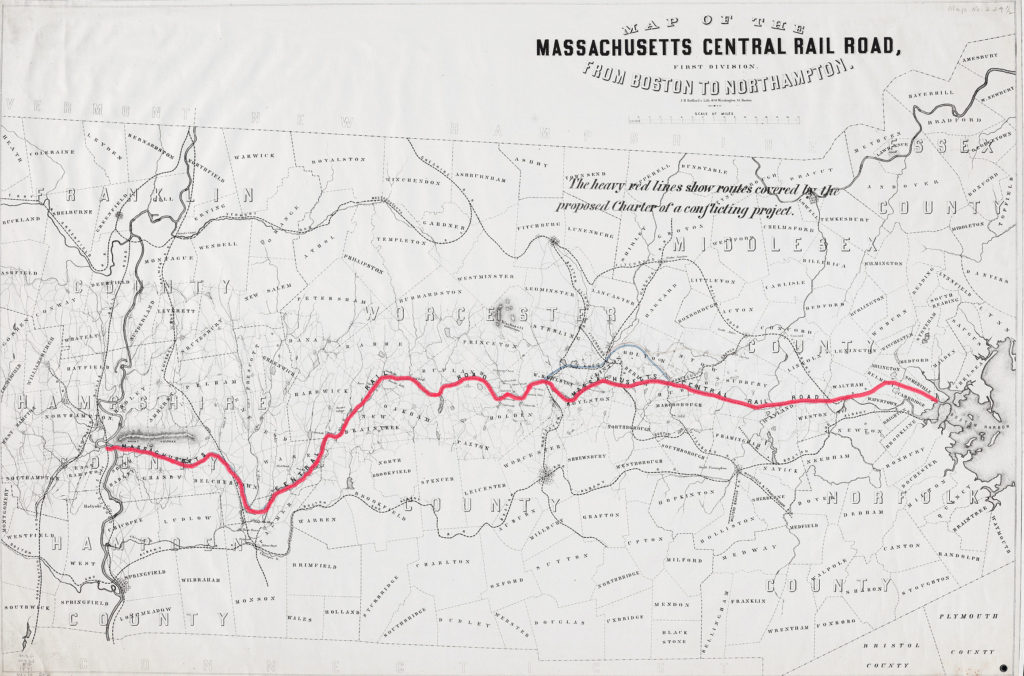
The proposed route of the Massachusetts Central Railroad from 1871. Map: Massachusetts State Archives.
Vincent Stanton, Jr., is a director of the Belmont Citizens Forum and a member of the Belmont Community Path Project Committee. This summary represents his personal perspective on the history of efforts to build an off-road path in Belmont.

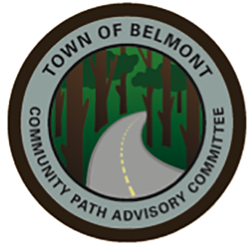
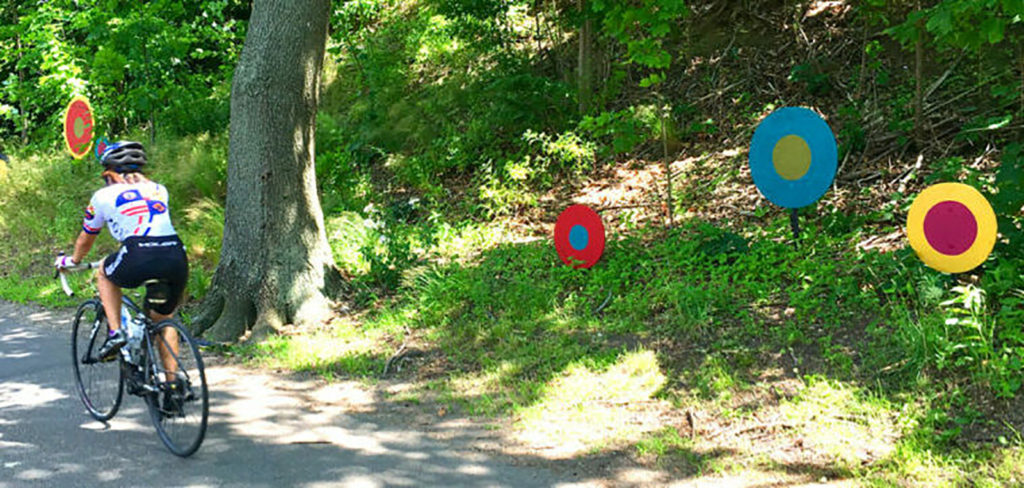

Sorry, the comment form is closed at this time.